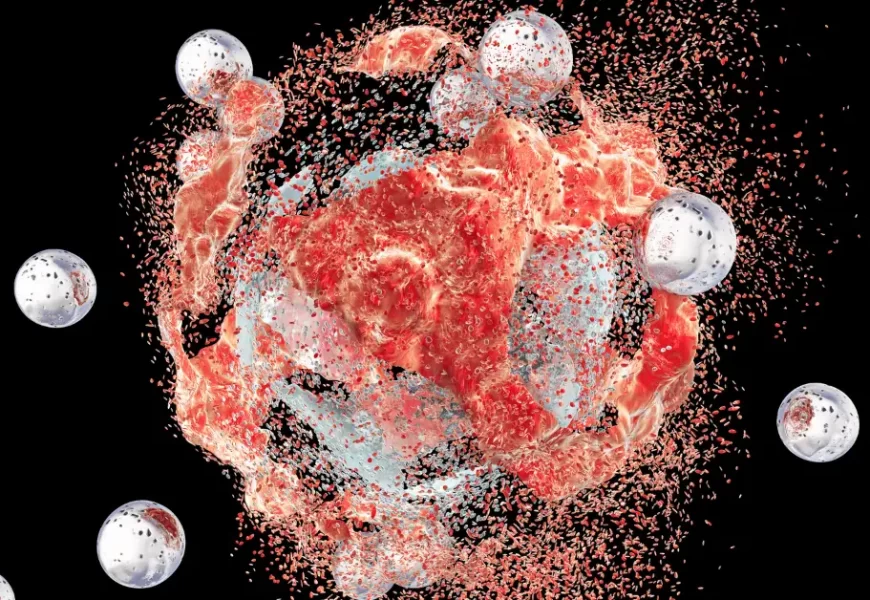In groundbreaking medical research, scientists have made an astonishing discovery: the human body possesses a built-in “kill switch” capable of destroying cancer cells. This breakthrough could revolutionize cancer treatment, offering a potential new weapon in the fight against one of the most persistent and deadly diseases. Researchers have been studying the body’s immune response and its ability to target and eliminate abnormal cells, and the findings are both promising and exciting. Let’s dive into what this discovery means for cancer patients and how it could change the landscape of cancer treatment.
1. Understanding the ‘Kill Switch’ Mechanism
The ‘kill switch’ discovered by scientists refers to a specific pathway within the immune system that can identify and destroy cancerous cells. The immune system is already equipped with T-cells and other components designed to fight infections, but until now, it was unclear whether these cells could recognize and target cancer cells effectively. This newly identified mechanism offers a direct way to activate these immune cells to go after cancerous growths, potentially halting the spread of the disease before it gets out of control.
2. The Role of the Immune System in Fighting Cancer
For years, cancer has been a major challenge because cancer cells often evade detection by the immune system. Cancer cells are known for disguising themselves to avoid being attacked by the body’s defenses. However, this new discovery offers hope by suggesting that the immune system can be “retrained” to identify and destroy cancer cells. The ‘kill switch’ mechanism provides a way to activate the immune system’s natural cancer-fighting abilities, a method which could work alongside traditional treatments like chemotherapy and radiation.
3. Potential for Personalized Cancer Treatments
One of the most exciting aspects of this discovery is the possibility of creating personalized cancer therapies based on the body’s own immune response. By understanding how the immune system can target specific types of cancer cells, researchers hope to develop more individualized treatment options. These treatments could be tailored to the genetic makeup of the patient’s cancer, increasing effectiveness and reducing side effects. Personalized treatments hold the promise of transforming cancer care into a more precise and less invasive process.
4. Cancer Vaccines and Immunotherapy Advancements
Building on this discovery, researchers are optimistic that we could see significant advancements in cancer vaccines and immunotherapy. These therapies would harness the power of the immune system to recognize and attack cancer cells directly. Immunotherapy has already shown great promise in the treatment of certain cancers, including melanoma and lung cancer, and this ‘kill switch’ discovery could help boost the effectiveness of these treatments. By stimulating the immune system to target cancer cells more efficiently, scientists hope to improve survival rates and potentially even eradicate cancer for some patients.
5. A Potential New Approach to Treatment Resistance
One of the most challenging aspects of cancer treatment is drug resistance. Over time, cancer cells can become resistant to chemotherapy and other forms of treatment, making it difficult to eliminate the disease. The discovery of the ‘kill switch’ offers hope for overcoming this problem. By harnessing the power of the immune system, it may be possible to attack cancer in a completely different way, bypassing the resistance mechanisms that allow cancer cells to survive. This could lead to longer-lasting and more effective treatments for patients who have developed resistance to conventional therapies.
6. Early-Stage Results: Encouraging but More Research Needed
While the discovery of the ‘kill switch’ is certainly promising, it’s important to note that the research is still in its early stages. Much more work needs to be done before these findings can be translated into widely available cancer treatments. Researchers will need to conduct clinical trials to determine the safety and effectiveness of therapies designed to activate the immune system’s natural cancer-killing abilities. However, the initial results are encouraging and suggest that we are on the cusp of a major breakthrough in cancer treatment.
7. Impact on Future Cancer Diagnostics
Another significant aspect of this discovery is its potential to improve cancer diagnostics. If the immune system can be trained to recognize cancer cells more effectively, it could lead to the development of more accurate diagnostic tests. Early detection is key to improving cancer outcomes, and this research could lead to more reliable, non-invasive tests for identifying cancer at its earliest stages. Improved diagnostics would allow for quicker intervention and more successful treatment outcomes.
8. Overcoming Current Cancer Treatment Limitations
Traditional cancer treatments, such as chemotherapy and radiation, come with significant limitations. These treatments can cause side effects that affect healthy cells, leading to complications such as nausea, fatigue, and immune system suppression. By tapping into the body’s own immune system, scientists hope to develop treatments that are not only more effective but also less toxic. The ‘kill switch’ mechanism could offer a more targeted approach, reducing the damage to healthy tissue and improving the patient’s overall quality of life during treatment.
9. Collaborative Efforts in Cancer Research
The discovery of the ‘kill switch’ underscores the importance of collaborative efforts in the fight against cancer. Scientists from various fields, including immunology, oncology, and genetics, are working together to unravel the complexities of cancer and the immune system. This interdisciplinary approach is crucial to advancing cancer treatments and bringing innovative solutions to patients in need. The discovery highlights how progress in medical research often comes from the combined knowledge and expertise of researchers worldwide.
10. The Hope for a Cure
While a cure for cancer may still be a long way off, this discovery offers a beacon of hope for millions of people affected by the disease. By unlocking the potential of the body’s immune system, we may be able to transform cancer from a life-threatening illness into a manageable condition. As research continues and new therapies are developed, patients can look forward to more effective, less invasive treatment options that could improve survival rates and the quality of life.
Final Thoughts
The discovery of the body’s ‘kill switch’ marks a significant step forward in cancer research. It brings hope to those fighting the disease and opens new possibilities for more personalized, effective treatments. While there’s still much to learn, the future of cancer treatment looks brighter than ever, with the potential for groundbreaking advancements that could save lives and offer a better quality of life for patients worldwide.




